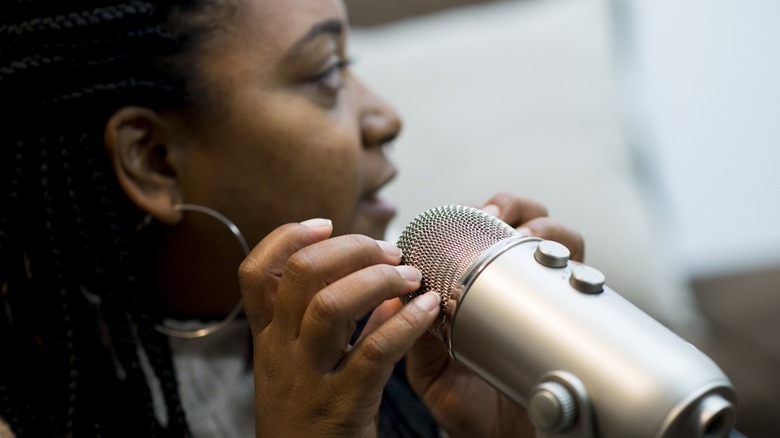What Does ASMR Stand For And Why Is It So Popular?
Ever stumbled upon a video of a stranger whispering into a microphone, tapping random objects, playing with slime, or devouring an feast of crunchy fried chicken and fiery Budak ramen noodles? Shockingly, you may have found yourself watching the entire video without the urge to swipe away and even wanting to watch more. While you may initially question why you found such a video oddly satisfying or why it triggered a strange tingling sensation your neck or limbs, you've just discovered exactly what ASMR is all about.
The term ASMR was coined in 2010 by Jennifer Allen, who started a Facebook group to explore a specific tingling sensation she was feeling. While the internet helped bring ASMR into the spotlight, people had been experiencing it for years without a specific name to reference the sensation they'd been feeling. Since then, ASMR began to grow in popularity rapidly across social media platforms like YouTube, Instagram, TikTok, Discord, and more. These satisfying videos range from short bit-sized Instagram Reels and TikToks to hours-long YouTube streams, racking up millions of views and big earnings for creators.
Due to its relatively recent emergence, there hasn't been a lot of dedicated scientific research into it. The term ASMR stands for "Autonomous Sensory Meridian Response," and refers to a "tingling, static-like sensation across the scalp, back of the neck and at times further areas in response to specific triggering audio and visual stimuli." Now that you know what the term stands for, let's look into why people worldwide are so obsessed with these odd yet satisfying sounds.
Why is ASMR so popular?
ASMR, or "Autonomous Sensory Meridian Response," refers to the pleasant tingling sensation that often starts at the scalp, may travel down the shoulders, and, in more intense experiences, can extend along the spine, arms, and legs. Some describe it like goosebumps brought on by sound. This experience is one of the primary reasons why ASMR has gained immense popularity. Many people find the soothing sounds and visuals in ASMR videos like whispering, tapping, soft crinkling, and even watching and listening to people eat, comforting and calming.
A study conducted by Barrat and Davis in 2015 indicated that ASMR might help alleviate depression, stress, and chronic pain, providing temporary relief to those affected. The study involved an online questionnaire consisting of 475 people, where various aspects of ASMR were explored, like the frequency of sessions, the amount of media consumed in a single session, and the time of the day participants would turn to ASMR content.
Notably, 98% of the participants reported that ASMR served as a source of relaxation, 82% used it to help them sleep, and 70% relied on it to deal with stress. In addition to that, 81% of participants engaged with ASMR media right before bed, further highlighting how the phenomenon is used as a tool for relaxation.
Does everyone experience ASMR, and what triggers it?
It's safe to say that the world of ASMR is a bit odd. What's even stranger is that not everyone experiences it, and some even find he sights and sounds irritating! According to a study published in 2022, individuals with elevated levels of anxiety are more likely to experience ASMR. Many studies have also shown that personality characteristics also come into play when it comes to experiencing ASMR. Ultimately, this means that while the sensation may help some individuals relax, it may not happen for others at all, or it may not be as intense. In fact, ASMR is also a highly individualized experience, and what triggers it varies from person to person.
So, what may induce the tingling sensation for one person might not necessarily have the same effect on another. A few common triggers include whispering, crinkling, mechanical keyboard sounds, and even personal attention roleplays, where the creator acts as if they're directly attending to the viewer's needs. Since ASMR is specific to an individual, it's also possible that someone just hasn't found the right trigger yet. Thankfully, the internet has made this much simpler, with an abundance of ASMR content available to explore. By experimenting with the numerous types of ASMR videos, the chances of finding a trigger that works are now higher than ever.


